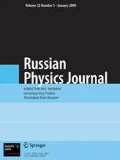Characteristics of thunderstorm cores, obtained from observations in Central and South Yakutia with the help of three one-point thunderstorm detectors with a radius of action of 300 km, located at Yakutsk, Mirnyi, and Neryungri, are presented. As a result of processing performed using two-step cluster analysis, the main parameters of thunderstorm cores have been obtained: number of discharges, area, intensity, transverse and longitudinal dimensions, shape, and lifetime. The distribution over occurrences of areas of cells has an exponentially falling form. It is shown that with increase of the mean area of an individual core S co in a thunderstorm, the area occupied by this thunderstorm S th grows exponentially, but with increase of the area of cores the density of discharges in them falls, and this dependence can be written in exponential form. The percent distribution of thunderstorms over density of discharges can be described by a falling power-law function.
Similar content being viewed by others
References
Instruction for a Lightning Protection Device for Buildings, Structures, and Industrial Communications [in Russian] (SO 153-34.21.122-2003).
E. A. Mareev and V. N. Stasenko, Izv. Ross. Acad. Nauk, Fiz. Atm. Okeana, 45, No. 5, 709–720 (2009).
I. I. Kononov and I. E. Yusupov, Radiotekh. Elektron., 49, No. 3, 283–291 (2004).
L. T. Matveev, Cloud Dynamics [in Russian], Gidrometeoizdat, Leningrad (1981).
M. H. Mogil, in: Extreme Weather, Black Dog & Leventhal Publishers, New York (2007), pp. 210–211.
S. N. Shabaganova and V. I. Kozlov, Dinam. Slozhn. Sist., 4, No. 2, 43–47 (2010).
V. I. Kozlov, V. A. Mullayarov, and R. R. Karimov, Sovrem. Probl. Dist. Zond. Zemli iz Kosmosa, 8, No. 3, 257–262 (2011).
V. I. Kozlov, V. A. Mullayarov, and A. E. Vasil’ev, Meteorol. Gidrol., No. 2, 3–25 (2003).
M. S. Aleksandrov, Usp. Sovrem. Radioelektron., No. 10, 3–25 (1998).
T. V. Lobodin and L. V. Oguryaeva, Trudy Gosud. Geofiz. Observ., Atm. Elektr., No. 350, 74–79 (1977).
A. A. Dul’zon and V. P. Gorbatenko, Izv. Tomsk. Politekh. Univ., 309, No. 2, 126–130 (2006).
I. I. Kononov and I. E. Yusupov, J. Commun. Technol. Electron., 49, No. 3, 1–9 (2004).
T. Rigo, N. Pineda, and J. Bech, Nat. Hazards Earth Syst. Sci., No. 10, 1881–1893 (2010).
T. V. Ershova and V. P. Gorbatenko, Vestn. Tomsk. Gosud. Pedagog. Univ., No. 5 (107), 150–154 (2011).
Author information
Authors and Affiliations
Corresponding author
Additional information
Translated from Izvestiya Vysshikh Uchebnykh Zavedenii, Fizika, No. 4, pp. 35–40, April, 2013.
Rights and permissions
About this article
Cite this article
Kozlov, V.I., Mullayarov, V.A. & Shabaganova, S.N. Characteristics of thunderstorm cores from observations in Yakutia. Russ Phys J 56, 398–404 (2013). https://doi.org/10.1007/s11182-013-0048-y
Received:
Revised:
Published:
Issue Date:
DOI: https://doi.org/10.1007/s11182-013-0048-y



